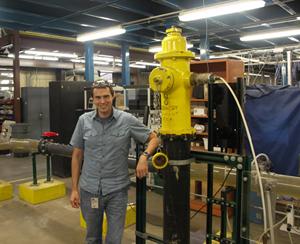Meet EPA Scientist Jeff Szabo, Ph.D.

EPA scientist Jeff Szabo, Ph.D., has worked for the EPA’s Homeland Security Research Program since 2005. He conducts and manages water security research projects at EPA’s Test and Evaluation facility. These projects include online water quality monitoring research as well as examining chemical, biological and radiological contaminant persistence on drinking water and waste water infrastructure and evaluation of decontamination methods. He has a BS in Chemical Engineering and a MS and PhD in Environmental Engineering, all from the University of Cincinnati and is a registered Professional Engineer in Ohio.
How does your science matter?
Sometimes it’s easy to forget how important clean water is to our daily lives. We need to be able to respond quickly when contaminants get into a water system, so we can clean it up and get it back into service fast.
I research better ways to keep our water systems safe and secure. We look at how to notify people if we find contaminants in the water supply, and how we can clean up water systems if they become contaminated. Using things like online water quality sensors, we can detect contamination and alert people.
As far as decontaminating a water system, my research helps us understand if certain contaminants stick to, or persist on, the kinds of pipes that are commonly used. And if so, how can we remove these “sticky” contaminants?
How do you do that kind of work?
I work in a huge building, about the size of a football field with 30-foot-high ceilings, that’s a big open space. We’ve built large-scale pipe systems where we’re able to introduce contaminants and test decontamination methods and sensors.
To test our methods, we use surrogates, safe non-pathogenic agents that act like dangerous contaminants. For example, we use a bacterium called bacillus globigii as a stand in for the far more dangerous bacillus anthracis, which causes anthrax. It is similar in its resistance to disinfection and its ability to stick to pipe material, and since it’s actually tougher to remove than bacillus anthracis, we know if we can get rid of it, we can definitely get rid of anthrax.
We’re also looking at finding commercially- available processes to treat large volumes of water, especially when it contains sediment and organic waste. Many treatment processes focus on treating contaminated water that is otherwise clean, which is a little easier.
Are you working on any other projects?
For the last seven years I have been working at EPA’s Water Security Test Bed (WSTB) at the Idaho National Lab (INL). The WSTB is 450 ft of drinking water pipe that we dug up and put back together above ground. It operates just like a water pipe under the street outside your house in a real city.
We conduct water security experiments at the WSTB, which mainly focus on infrastructure decontamination and water treatment. We are currently building up a full scale system that will be used for cybersecurity research. This is an exciting new area that has considerable interest from the water sector.
What do you like most about your research?
I like the applied nature of water security research and working with these large scale pilot projects. A lot of people would probably hate it down here in our lab because we’re located on the grounds of the main sewer plant in Cincinnati, but the advantages of working in such a big space make it pretty cool.
If you could have dinner with any scientist, past or present, who would you choose and what would you like to ask them?
Thomas Edison would be a good choice because he did a lot of great research in his life, and he is known for doing everything in an applied fashion. I’d like to ask him how he stayed so prolific throughout his life. We work on a lot of projects in my lab and sometimes, as we progress through them, thinking about the next project is difficult, so I’d like to get his advice.
When did you first know you wanted to be a scientist?
When I was in college, I chose chemical engineering because I thought, hey, I could probably get a job with that degree. As I continued on my path, I became interested in the environmental side of things. Interestingly enough, my father is also an environmental engineer. The fact that he did environmental work was always interesting to me.
Tell us about your background.
I went to the University of Cincinnati where I received a Bachelors degree in chemical engineering. I also have a Master’s degree and PhD in environmental engineering.
If you weren’t a scientist, what do you think you would be doing?
I think I’d be perfectly happy being a stay-at-home dad. I’m the chair of the board for our on-site daycare center now, which is something I never saw myself doing. It has really given me an inside look at what it takes to run childcare centers, and it would be interesting to be more involved.
Any advice for students considering a career in science?
I’d encourage kids to go into a scientific field, whether it’s environmental, industrial, or computer science. I think the United States needs more scientists. It’s a profession that many people have shied away from and that needs to change. It’s a very rewarding career no matter what you are doing.
Editor's Note: The opinions expressed herein are those of the researcher alone. EPA does not endorse the opinions or positions expressed.
